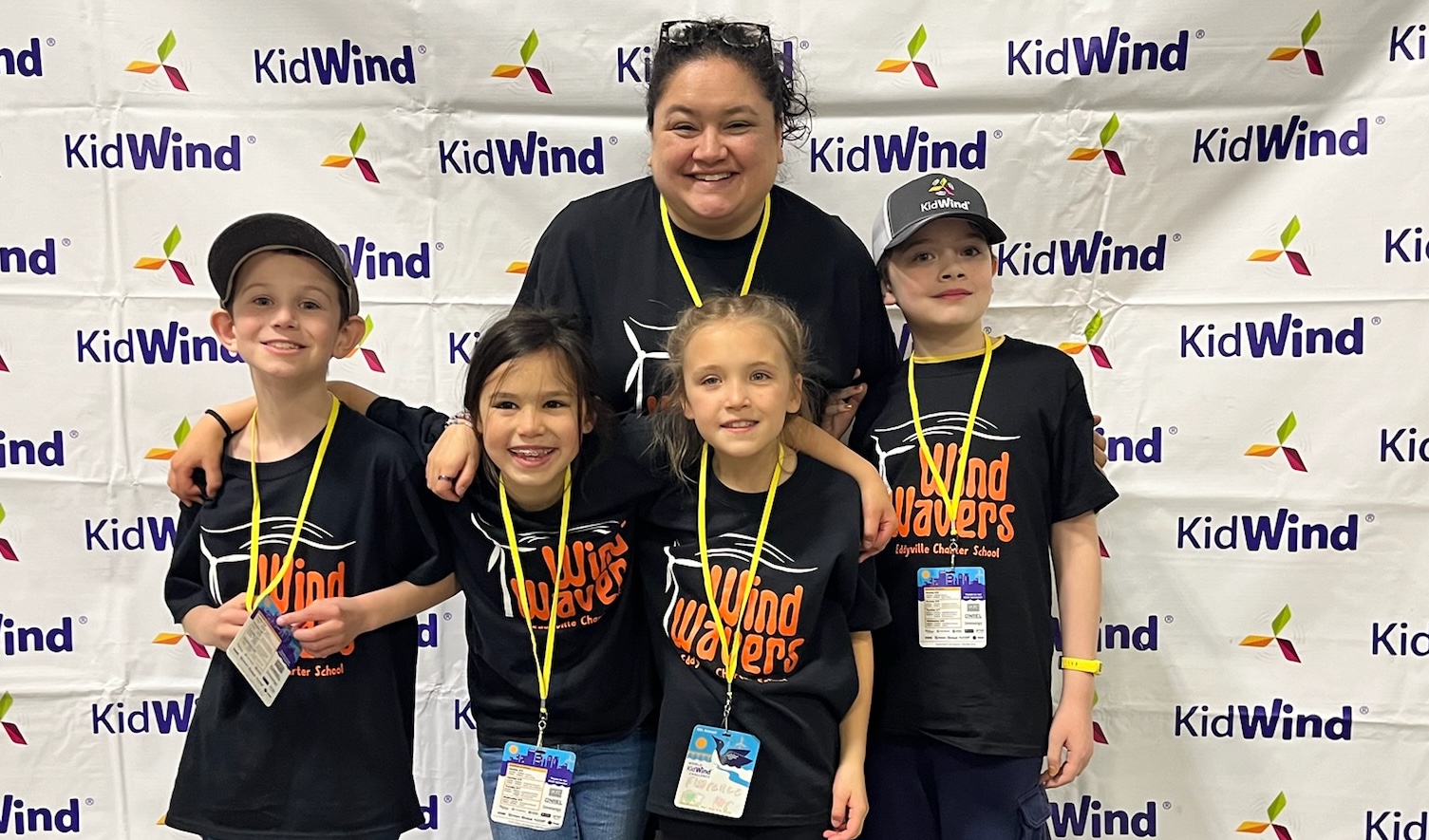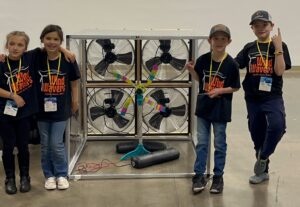
By KATHLEEN O’CONNOR/YachatsNews
The Minneapolis Convention Center is a very big place, overwhelming for almost everyone, especially huge in the eyes of four Lincoln County third- and fourth- graders there to compete in the KidWind World Challenge.
 Lane Aleckson, Aurora Graves, Florence Doyle, and Talanoa Kilduff traveled there last month with their coach, Melaia Kilduff, for the four-day competition. They were there to see how their wind turbine would perform against 95 other teams from 21 states, Mexico, and Taiwan. They qualified to go after winning in their grade level at the Oregon Coast Renewable Energy Challenge in March.
Lane Aleckson, Aurora Graves, Florence Doyle, and Talanoa Kilduff traveled there last month with their coach, Melaia Kilduff, for the four-day competition. They were there to see how their wind turbine would perform against 95 other teams from 21 states, Mexico, and Taiwan. They qualified to go after winning in their grade level at the Oregon Coast Renewable Energy Challenge in March.
KidWind is a nonprofit organization with two aims. Besides putting on the KidWind Challenge, it creates curriculum for teachers to use when teaching about renewable energy, both wind and solar, using science and technology.
Lane, Aurora, Florence, and Talanoa are students at the Eddyville Charter School. Kilduff is Talanoa’s mother and a Waldport native who volunteered to lead a team.
Nominated by their teachers, five students joined the team, calling themselves the Wind Wavers. The fifth student was Emma Soto, who was not able to go to Minneapolis.
Kilduff taught at Crestview Heights School in Waldport for eight years and used KidWind materials whenever she taught fourth grade. The Lincoln County School District used it for several years, receiving funding from OSU Sea Grant and the Oregon Coast STEM Hub.
Kilduff is currently the executive director for Lincoln County Partnership Against Alcohol and Drug Abuse, and is on the Waldport city council.

Question: Please tell me more about building the turbine?
The kids’ answers: We watched videos on YouTube to get ideas. We decided to make ours out of balsa wood and hot glue. We made it with four blades, and we created our own shape. We bought a tower from KidWind, and attached the turbine to that each time we tested it. When we got to the competition we saw that some of the teams had added gears and fins to their turbines so while we were there we changed ours quite a bit. We colored our turbine with highlighters and got many of the volunteers to sign the back of the blades when we were done. We each get to keep one blade.
Q: How was your turbine tested?
A: The turbine was tested in three wind tunnels. The first one had wind going at 3.5 meters per second. The second one was 5.5 meters per second, and the last one was 7.5 meters per second. In the last tunnel our turbine went so fast. It generated 15 jewels of energy … it went much faster than it had ever gone in our tests at home. We were all afraid it was going to fly apart. The fin and the gears that we added when we got there made a big difference.
Q: What were the other parts of the competition?
A: We had to do a 20-minute presentation to the judges telling them about our design and how we made decisions and how we made the turbine. We had practiced it about 15 times.
We also had to do a collaborative challenge. The challenge was to build a floating wind turbine. College kids from the University of Massachusetts helped us. Our turbine didn’t float … it fell over right away. But so did everyone else’s. There was only one floating wind turbine out of 95 that actually floated.
And we had to do two 30-minute instant challenges. For one we had to create a vertical wind turbine. For the other one we were given a map and wind-related facts, and we had to decide on the best place to put the wind turbine on the map.
There was also a quiz bowl with lots of questions about wind turbines and electricity. We had gotten study questions ahead of time, but we still didn’t know all the answers.
Q: You received an award at the competition. What was it for?
A: It was the Judge’s Award. Six teams got one. We couldn’t believe it when our name was called. It was for outstanding teamwork, for doing a good presentation to the judges, and because all of us were excited to participate in everything.
Q: Would you enter this competition again? What would you tell other students about it?
A: It was awesome. We had so much fun. We all hope we can do it again, and we hope more kids from around here will get to do it, too.
Tell us a secret
For the Oregon challenge we only worked on our turbine for six hours, but we knew we had to work harder for the challenge in Minneapolis so we studied at home and worked on the turbine at our lunch recess every day from March until May.
- Kathleen O’Connor is a Waldport freelance writer who can be reached via email at kmoc8916@gmail.com


